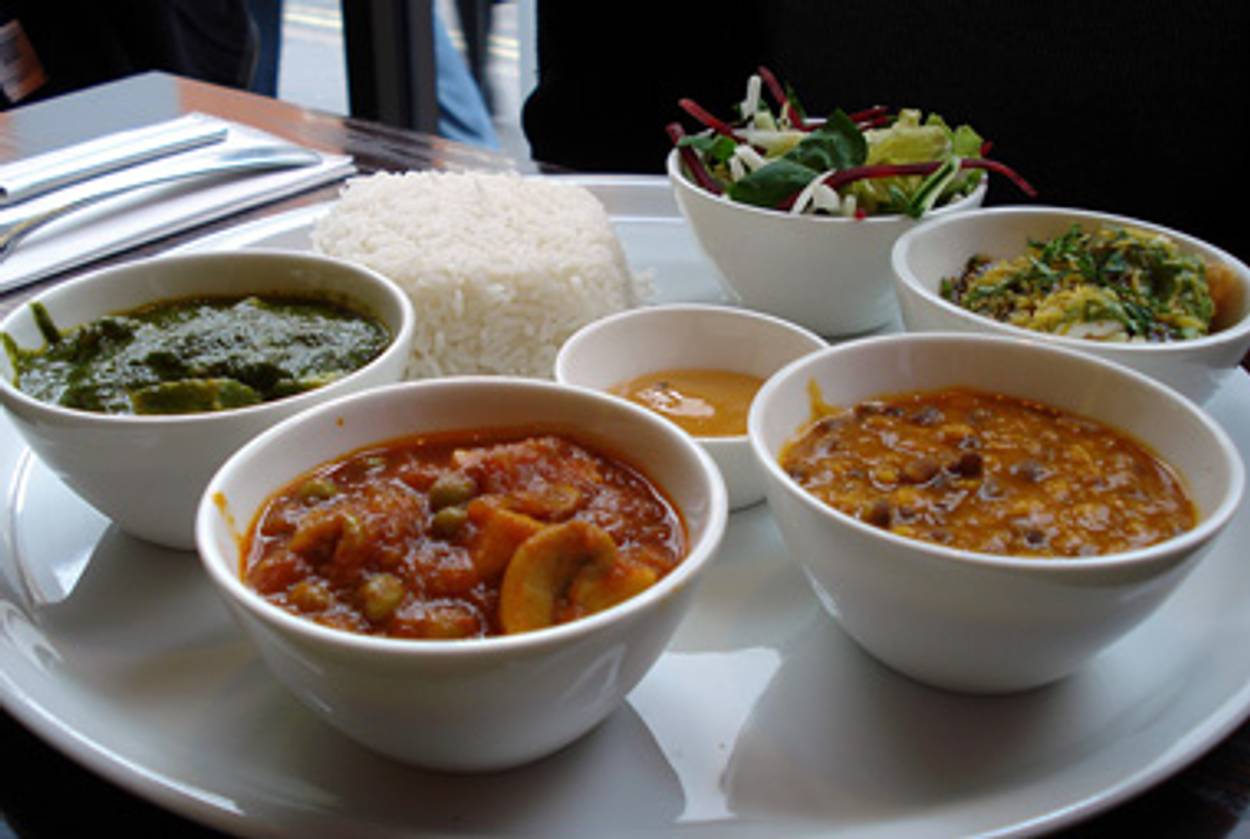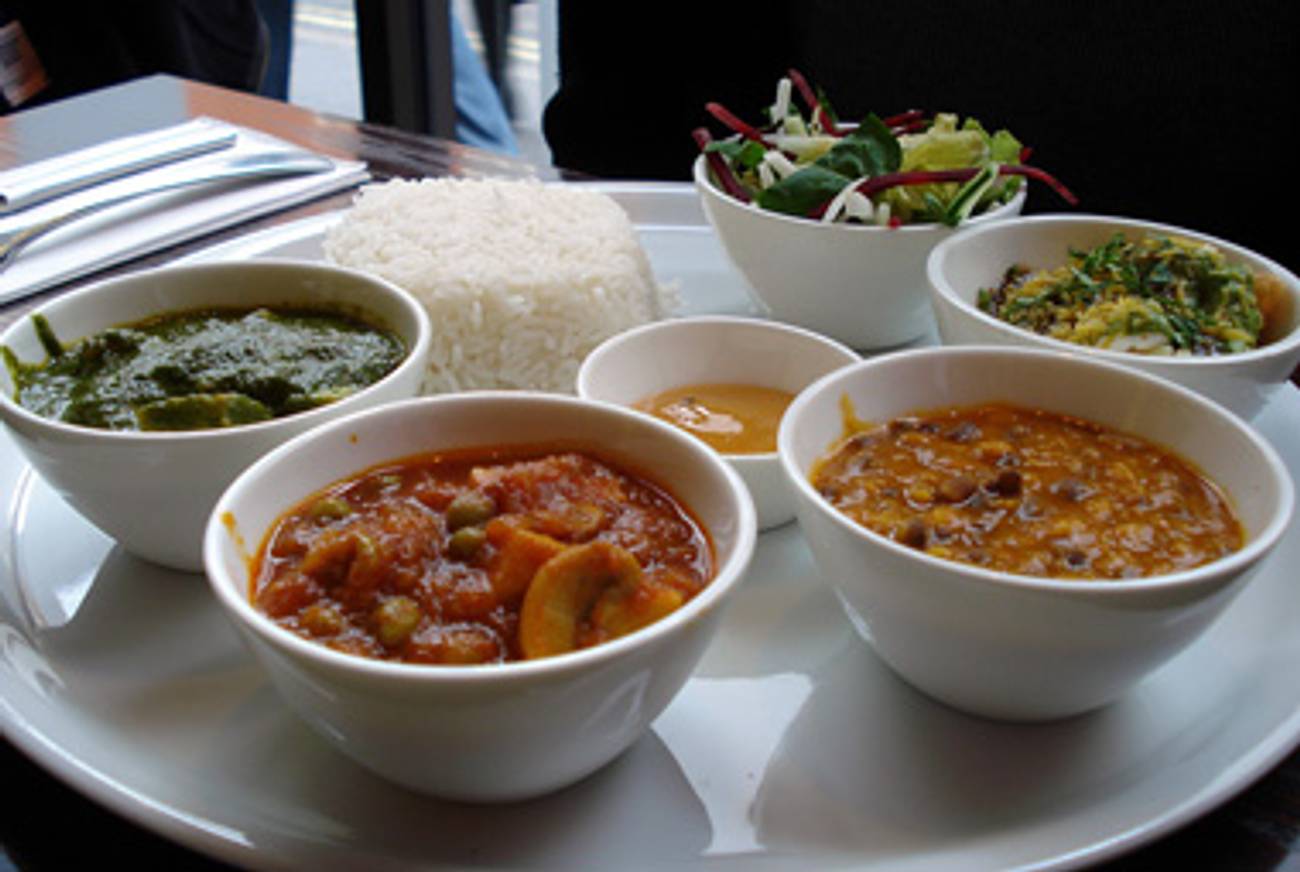Passage to India
The kosher appeal of subcontinental cuisine




Iddly. Vadai. Bhel Puri. Alu Chaat. Bhajia. Dosai. Uttapam. Not some ancient pagan chant that but, rather, opulently exotic dishes that taste totally, blissfully foreign to palates trained on the Ashkenazic flavor paradigm. Even Sephardim who are used to the bright and complex spicings of the Mediterranean region and Middle East may be pleasantly shocked by the intricacies, colors, and textures of India’s ingenious vegetarian preparations. The biggest—and best—surprise might come from discovering that in a growing number of authentic Indian vegetarian restaurants around the country, the food is strictly kosher, complete with presiding mashghiachs who certify that all dietary regulations are fully met. The result is an entertaining and encouraging scene of culinary assimilation, as yarmulkes meet saris, especially on Sunday, the day of familial feasting.
Restaurants that feature the specialties of India’s southern Madras region, along with those of Gujarat and Punjab in the north, cook for members of Hindu sects, such as the Jain, who adhere to the strictest vegetarian diets, shunning meat, fish, eggs, and cheese set with rennet. These restaurants were thus de facto kosher and their owners sought the corresponding certification as they realized they could attract a potential new group of customers.
About 30 years ago, I was introduced by Indian friends to just such a restaurant in Manhattan, Madras Woodlands, now relocated to Long Island. N.Y. I was unaware that it was vegetarian, and it was not yet kosher. My friends ordered an intriguing meal of savory diversity—crunchy and hotly spiced appetizer salads of crisped rice puffs and legumes, followed by a rainbow of saucy curries of mellow eggplant, okra, cauliflower and green beans, parchment crisp breads, juicy biryanis golden with saffron and flecked with dates and nuts, soothing sauces based on yogurt and black lentils, fiery but gently soft pancakes dotted with peas and onions or white cheese or coconut and cilantro. There was so much heft to flavors and rich textures that were so organoleptically satisfying, that I never missed having any meat.
Since then I have frequented Madras Mahal, a New York favorite, although others here, such as Chennai Garden and Pongal, have been well-reviewed. Outside of the northeast, you can find Madras Pavilion in Texas, Amma’s Kitchen in Cincinnati, and Pabla Indian Cuisine in Seattle.
If you have suggestions of certified kosher vegetarian Indian restaurants where you live, let us know by sending an email to [email protected].
Newcomers to the Indian vegetarian meal might find it useful to have a brief glossary. The following are fairly typical of all such menus as are inexpensive weekday buffet lunches.
Appetizers
Iddly: snowy white, semolina-like steamed dumplings of lentil and rice, with various dips
Vadai: crisply fried lentil crullers, with various dips
Kachori: crunchy fried balls of chickpeas and green pea
Bhel puri: a tossing of rice puffs, thin noodles, golden wisps of onions, and sweet-sour sauce
Bhaji: sliced vegetables fried in a golden batter
Chaat: potato (alu), chickpeas (channa), or fruits flavored with mint and spice
Samosa: lightly fried turnovers plumped with spiced vegetables
Dosai and Breads
Dosai: huge parchment thin and crisp folded sheets of a bread-crepe baked on a stone griddle, usually plain or filled with seasoned butter-mashed potatoes
Paratha: flaky layered bread that may be stuffed
Poori: huge puffed whole wheat balloons
Chappati: unspiced whole wheat flat bread
Rice dishes
Pilaus and biryanis: sweetly scented basmati rice tossed with various vegetables, saffron, tomato, dried fruits, nuts, and spices
Main courses
Uttapam: eggless pancake omelets of rice and lentil flours filled with various vegetables
Vegetable curries: softly aromatic stews based on okra, eggplant, greenbeans, spinach, and legumes
Alu gobhi: cauliflowerets with potato, ginger, garlic, and other spices
Garnishes
Raita: yogurt sauce that may have cucumber, coriander, or spices—a must with hotly seasoned dishes
Daal: a velvety sauce of simmered yellow or, preferably, black lentils
Chutney: pungent relishes of lemon, onion, mango, and more
Desserts
Kheer: a soft sort of white custard of rice, sugar, milk, and almonds
Kulfi: milk ice cream subtly seasoned with cardamom, almonds, pistachios, and rosewater
Jalebi: fried squiggles of dough in sweet syrup
Mimi Sheraton is a former restaurant critic for The New York Times and the author of several books including The Bialy Eaters.
Mimi Sheraton is a former restaurant critic for The New York Times and the author of several books including The Bialy Eaters.